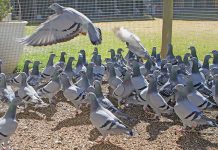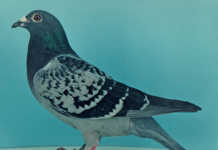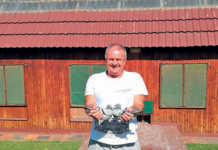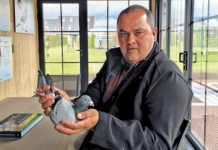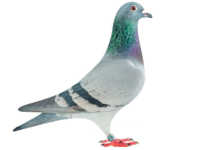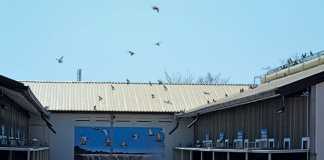Courting cocks
During mating, cocks and hens act out a dramatic play of courtship that reminds one of a Shakespearian plot. The hard-to-get act of a hen during the desperate cock’s cry in the nest bowl to lure her closer, is a sight to behold. Once she’s convinced, the pair unite in the nest bowl for hours, gently “kissing” (beaking) and pecking on each other’s head and neck.
Territorial wars
Then follows the arrival of the jealousy stage and marking of territory against other pairs. A fight between two cocks can leave them with bleeding eyelids and a scalped head, unless rescued by human intervention. Once bonded to her mate, a hen will join in defence of the nest and take on any other cock that trespasses. The couple now has to set up a nest. It is a treat to see them dashing and diving for nest material. Straw, sticks and feathers are collected from all over the place and often stolen from another nest.
Dedicated brooding
A new contentment arrives after eight to 10 days of mating, when the first eggs are laid. The next batch follows two days later. Cocks incubate on the eggs during the day and hens during the night. Shift-changing is a rewarding sight. Changing shifts is often done reluctantly, sometimes aggressively and some parents even refuse to hand over entirely to their mate. Often both partners are seen sitting on the nest together.
When the new hatchlings arrive at about the 17th day of incubation, they’re fed curd (crop milk) by regurgitating directly into the opened beak. The parents move slowly in the nest when leaving so their chicks will not get hurt. The new yellow, fluffy youngster is just as sensitive and fragile as a newborn human baby. The parents will protect their young with their lives. It is often mentioned how brave parent birds fought off rats or snakes and even larger animals of prey, often at the cost of their own lives.
Family ties Once the youngster reaches some 10 days of age, the crop milk discontinues and fine seeds are fed. As the youngsters reach two weeks of age, the feed ingredients include large seeds like mealies, peas and beans. At this stage the hen lays a new batch of eggs and often allows the cock to feed the youngsters.
The bonds between the family members are evident when parents and youngsters are seen cuddling each other. Broody cocks are often seen feeding youngsters begging for food, even though it may not be their own. Hens, however, are threatened by alien youngsters and may attack them when entering her nest.
Preparing for flight
It’s a treat to see the newly weaned 21-day-old young enjoy their first bath and time out in the sun. Once the newly bred team is strong, training for the races start. Each bird is recognised by its unique personality traits. Some birds bond with their owners in a significant way. They often put on a brave act against the elements to score at the top in a competition. This illustrates the bird’s love for its loft, owner and friend.
It is a picturesque sight to see birds training in the skies against the rising sun or the sheltering skylight at nightfall. When the first bird returns to its loft after completing a race, it lands swiftly and gracefully on the landing board. Then follows the dramatic cooing of the cocks and tail-sweeping of the hens as they enter the lofts, greeting everyone. I remember watching with amazement how a cock returning from Matjiesfontein to Pretoria rushed straight to its young and endeavoured to feed it, without having eaten upon arrival.


